A Study on the Influencing Factors of the Vitality of Street Corner Spaces in Historic Districts: The Case of Shanghai Bund Historic District
Abstract
:1. Introduction
2. Research Concepts
2.1. Historic Districts
2.2. Street Corner Space
3. Influencing Factors of Street Corner Vitality and Selection of Indicators for Crowd Vitality Measurement in Historical Neighborhoods
3.1. Selection of Factors Influencing Crowd Vitality on Street Corners
3.1.1. Historical Imagery
3.1.2. Corner Building Functions
3.1.3. Spatial Form of Street Corners
3.1.4. Street Corner Space Functions
3.2. Selection of Indicators for Measuring Crowd Vitality in Street Corner Spaces
3.2.1. Average Vigor Density and Vigor Stability
3.2.2. Age Diversity in Active Populations and Diversity of Activity Types
4. Research Methodology, Sample Selection, Data Sources, and Processing
4.1. Research Methodology and Framework
4.2. Study Area and Sample Selection
4.2.1. Scope of the Study
4.2.2. Study Sample Selection
4.3. Data Sources
4.3.1. Network Access
4.3.2. Questionnaires
4.3.3. Field Surveys and Manual Statistics
4.3.4. Machine Learning Processing of Street Corner Images
4.4. Data Processing Methods and Results
4.4.1. Street Corner Vitality Influencing Factors
4.4.2. Measurement of Crowd Vitality in Street Corner Spaces
4.4.3. Multiple Linear Regression Analysis
5. Discussion
6. Conclusions
Author Contributions
Funding
Data Availability Statement
Conflicts of Interest
References
- Lyu, Y.; Abd Malek, M.I.; Jaafar, N.H.; Sima, Y.; Han, Z.; Liu, Z. Unveiling the potential of space syntax approach for revitalizing historic urban areas: A case study of Yushan Historic District, China. Front. Archit. Res. 2023, 12, 1144–1156. [Google Scholar] [CrossRef]
- Hu, Y.; Gan, Y.; Kang, Z. Spatial Vitality and Influencing Factors at Corners of Commercial Streets: A Tianjin Case Study. South Archit. 2023, 40–48. [Google Scholar]
- Herriott, R. The topological relations of corner buildings at street junctions. J. Archit. Urban. 2016, 40, 322–334. [Google Scholar] [CrossRef]
- Sun, Y.; Wang, Y.; Dai, D. From the direction to the path: Reflections on the development of urban street in my country. J. Archit. 2020, 154–158. [Google Scholar]
- Jacobs, J. The Death and Life of Great American Cities; Vintage Books: New York, NY, USA, 2012. [Google Scholar]
- Lynch, K. Good City Form; Design; MIT Press: Cambridge, MA, USA, 1984. [Google Scholar]
- Gehl, J.; Kaefer, L.J.; Reigstad, S. Close encounters with buildings. Urban Des. Int. 2006, 11, 29–47. [Google Scholar] [CrossRef]
- Racine, F. Developments in urban design practice in Montreal: A morphological perspective. Urban Morphol. 2016, 20, 122–137. [Google Scholar] [CrossRef]
- Sung, H.G.; Go, D.H.; Choi, C.G. Evidence of Jacobs’s Street life in the great Seoul city: Identifying the association of physical environment with walking activity on streets. Cities 2013, 35, 164–173. [Google Scholar] [CrossRef]
- Jalaladdini, S.; Oktay, D. Urban public spaces and vitality: A socio-spatial analysis in the streets of Cypriot towns. Procedia-Soc. Behav. Sci. 2012, 35, 664–674. [Google Scholar] [CrossRef]
- Ma, Z. Deep exploration of street view features for identifying urban vitality: A case study of Qingdao city. Int. J. Appl. Earth Obs. Geoinf. 2023, 123, 103476. [Google Scholar] [CrossRef]
- Ma, X.; Wu, C.; Xi, Y.; Yang, R.; Chen, Z. Measuring human perceptions of streetscapes to better inform urban renewal: A perspective of scene semantic parsing. Cities 2021, 110, 103086. [Google Scholar] [CrossRef]
- Shin, H.S.; Woo, A. Analyzing the effects of walkable environments on nearby commercial property values based on deep learning approaches. Cities 2024, 144, 104628. [Google Scholar] [CrossRef]
- Zikirya, B.; He, X.; Li, M.; Zhou, C. Urban food takeaway vitality: A new technique to assess urban vitality. Int. J. Environ. Res. Public Health 2021, 18, 3578. [Google Scholar] [CrossRef] [PubMed]
- Jia, C.; Liu, Y.; Du, Y.; Huang, J.; Fei, T. Evaluation of urban vibrancy and its relationship with the economic landscape: A case study of Beijing. ISPRS Int. J. Geo-Inf. 2021, 10, 72. [Google Scholar] [CrossRef]
- Liu, S.; Zhang, L.; Long, Y.; Long, Y.; Xu, M. A new urban vitality analysis and evaluation framework based on human activity modeling using multi-source big data. ISPRS Int. J. Geo-Inf. 2020, 9, 617. [Google Scholar] [CrossRef]
- Delclòs-Alió, X.; Gutiérrez, A.; Miralles-Guasch, C. The urban vitality conditions of Jane Jacobs in Barcelona: Residential and smartphone-based tracking measurements of the built environment in a Mediterranean metropolis. Cities 2019, 86, 220–228. [Google Scholar] [CrossRef]
- Yue, W.; Chen, Y.; Thy, P.T.M.; Fan, P.; Liu, Y.; Zhang, W. Identifying urban vitality in metropolitan areas of developing countries from a comparative perspective: Ho Chi Minh City versus Shanghai. Sustain. Cities Soc. 2021, 65, 102609. [Google Scholar] [CrossRef]
- Kim, Y.L. Seoul’s Wi-Fi hotspots: Wi-Fi access points as an indicator of urban vitality. Comput. Environ. Urban Syst. 2018, 72, 13–24. [Google Scholar] [CrossRef]
- Zeng, P.; Wei, M.; Liu, X. Investigating the spatiotemporal dynamics of urban vitality using bicycle-sharing data. Sustainability 2020, 12, 1714. [Google Scholar] [CrossRef]
- Ta, N.; Zeng, Y.; Zhu, Q.; Wu, J. Analysis of the relationship between built environment and urban vitality in central Shanghai based on big data. Sci. Geogr. Sin. 2020, 40, 60–68. [Google Scholar]
- Zhang, Y.; Shang, K.; Shi, Z.; Wang, H.; Li, X. Spatial pattern of the vitality of Chinese characteristic towns: A perspective from nighttime lights. Land 2022, 11, 85. [Google Scholar] [CrossRef]
- Kim, Y.L. Data-driven approach to characterize urban vitality: How spatiotemporal context dynamically defines Seoul’s nighttime. Int. J. Geogr. Inf. Sci. 2020, 34, 1235–1256. [Google Scholar] [CrossRef]
- Huang, B.; Zhou, Y.; Li, Z.; Song, Y.; Cai, J.; Tu, W. Evaluating and characterizing urban vibrancy using spatial big data: Shanghai as a case study. Environ. Plan. B Urban Anal. City Sci. 2020, 47, 1543–1559. [Google Scholar] [CrossRef]
- Sung, H.; Lee, S. Residential built environment and walking activity: Empirical evidence of Jane Jacobs’ urban vitality. Transp. Res. Part D Transp. Environ. 2015, 41, 318–329. [Google Scholar] [CrossRef]
- Corbusier, L.; Eardley, A. The Athens Charter; Grossman Publishers: New York, NY, USA, 1973; p. 88. [Google Scholar]
- Kolonias, S.A. Charter for the Conservation of Historic Towns and Urban Areas (Washington 1987); Springer: New York, NY, USA, 2014. [Google Scholar]
- Jacobs, A.B. Great Streets; No. qt3t62h1fv; University of California Transportation Center: Berkeley, CA, USA, 1993. [Google Scholar]
- Mao, Y.; Qi, J.; He, B.J. Impact of the heritage building façade in small-scale public spaces on human activity: Based on spatial analysis. Environ. Impact Assess. Rev. 2020, 85, 106457. [Google Scholar] [CrossRef]
- Wang, C.; Wang, B.; Wang, Q.; Lei, Y. Nonlinear associations between urban vitality and built environment factors and threshold effects: A case study of central Guangzhou City. Prog. Geogr. 2023, 42, 79–88. [Google Scholar] [CrossRef]
- Ye, Y.; Zhuang, Y.; Zhang, L.; van Ness, A. A Morphological Inquiry into Vitality Creation in Urban Design—Based on Quantitative Analysis of Urban Spatial Morphological Characteristics and Examination of Residents’ Activities. Int. Urban Plan. 2016, 31, 26–33. [Google Scholar]
- Lu, Y. Using Google Street View to investigate the association between street greenery and physical activity. Landsc. Urban Plan. 2019, 191, 103435. [Google Scholar] [CrossRef]
- Wang, R.; Lu, Y.; Zhang, J.; Liu, P.; Yao, Y.; Liu, Y. The relationship between visual enclosure for neighbourhood street walkability and elders’ mental health in China: Using street view images. J. Transp. Health 2019, 13, 90–102. [Google Scholar] [CrossRef]
- Li, X.; Cai, B.Y.; Ratti, C. Using street-level images and deep learning for urban landscape studies. Landsc. Archit. Front. 2018, 6, 20–30. [Google Scholar] [CrossRef]
- Tang, J.; Long, Y. Measuring visual quality of street space and its temporal variation: Methodology and its application in the Hutong area in Beijing. Landsc. Urban Plan. 2019, 191, 103436. [Google Scholar] [CrossRef]
- Chen, Y.; Zhao, X. A study on street subterranean interface based on pedestrian’s perspective—A case study of Huaihai Road in Shanghai. Urban Plan. 2014, 38, 24–31. [Google Scholar] [CrossRef]
- Lynch, K. The image of the city (1960). In Anthologie zum Städtebau. Band III: Vom Wiederaufbau nach dem Zweiten Weltkrieg bis zur Zeitgenössischen Stadt; Gebr. Mann Verlag: Regensburg, Germany, 2023; pp. 481–488. [Google Scholar]
- Ewing, R.; Handy, S. Measuring the unmeasurable: Urban design qualities related to walkability. J. Urban Des. 2009, 14, 65–84. [Google Scholar] [CrossRef]
- Gehl, J. Life between Buildings; The Danish Architectural Press: Copenhagen, Denmark, 2011. [Google Scholar]
- Yin, J.X. Summary of research methods on urban space vitality. Sichuan Arch. 2019, 39, 54–57. [Google Scholar]
- Liu, S.; Lai, S. Influence Factors of Urban Public Space Vitality Based on Multi-source Data: A Case Study of Huangpu River Waterfront Area of Shanghai. Landsc. Archit. 2021, 28, 75–81. [Google Scholar]
- Mao, Z.R.; Chen, X.K.; Xiang, Z.H.; Chen, Y.R. Research on the measurement and influencing factors of street vigour in historic districts: A case study of Wenming Street historic district in Kunming. South Archit. 2021, 4, 54–61. [Google Scholar]
- Zhang, L.; Pei, T.; Chen, Y.; Song, C.; Liu, X. A review of urban environmental assessment based on street view images. J. Geo-Inf. Sci. 2019, 21, 46–58. [Google Scholar]
- Xu, L. The Bund Building No. 12—A Representative Architecture of the Historical and Cultural Style Protection Area of the Bund in Shanghai. Available online: http://www.pipcn.com/research/201012/14594.htm (accessed on 7 August 2024).
- Xie, E.; Wang, W.; Yu, Z.; Anandkumar, A.; Alvarez, J.M.; Luo, P. Segformer: Simple and efficient design for semantic segmentation with transformers. Adv. Neural Inf. Process. Syst. 2021, 34, 12077–12090. [Google Scholar]
- Varghese, R.; Sambath, M. YOLOv8: A Novel Object Detection Algorithm with Enhanced Performance and Robustness. In Proceedings of the 2024 International Conference on Advances in Data Engineering and Intelligent Computing Systems (ADICS), Chennai, India, 18–19 April 2024; IEEE: Piscataway, NJ, USA, 2024. [Google Scholar]
- Sharifi, A. From Garden City to Eco-urbanism: The quest for sustainable neighborhood development. Sustain. Cities Soc. 2016, 20, 1–16. [Google Scholar] [CrossRef]
- Sharma, A.; Singh, S. A review on data normalization techniques in data mining. Int. J. Comput. Sci. Inf. Secur. 2017, 15, 1–6. [Google Scholar]
- Han, J.; Kamber, M.; Pei, J. Data Mining: Concepts and Techniques; Elsevier: Amsterdam, The Netherlands, 2011. [Google Scholar]
- Cabello-Solorzano, K.; Ortigosa de Araujo, I.; Peña, M.; Correia, L.; J Tallón-Ballesteros, A. The impact of data normalization on the accuracy of machine learning algorithms: A comparative analysis. In Proceedings of the 18th International Conference on Soft Computing Models in Industrial and Environmental Applications, Salamanca, Spain, 5–7 September 2023; Springer Nature: Cham, Switzerland, 2023; pp. 344–353. [Google Scholar]
- Yu, S.; Ding, H.; Zeng, Y. Evaluating water-yield property of karst aquifer based on the ahp and cv. Sci. Rep. 2022, 12, 3308. [Google Scholar] [CrossRef]
- Oliveira Neto, E.A.; Gonçalves, L.; Moreira, F.; Santana, W.; Maués, L.M. Assessment of the Influence of Contracting Models on the Well-Being of Construction Workers in the Brazilian Amazon. Buildings 2024, 14, 2539. [Google Scholar] [CrossRef]
- Kafle, S.C. Correlation regression analysis using SPSS. Manag. Technol. Soc. Sci. 2019, 126. Available online: https://journal.oxfordcollege.edu.np/file/1681898552journal-1.pdf#page=126 (accessed on 7 August 2024).
- Whang, S.W.; Park, K.S.; Kwon, C. Influence of aesthetic design elements on residential satisfaction in apartment Based on Seoul apartment complex. J. Asian Archit. Build. Eng. 2024, 23, 1381–1392. [Google Scholar] [CrossRef]
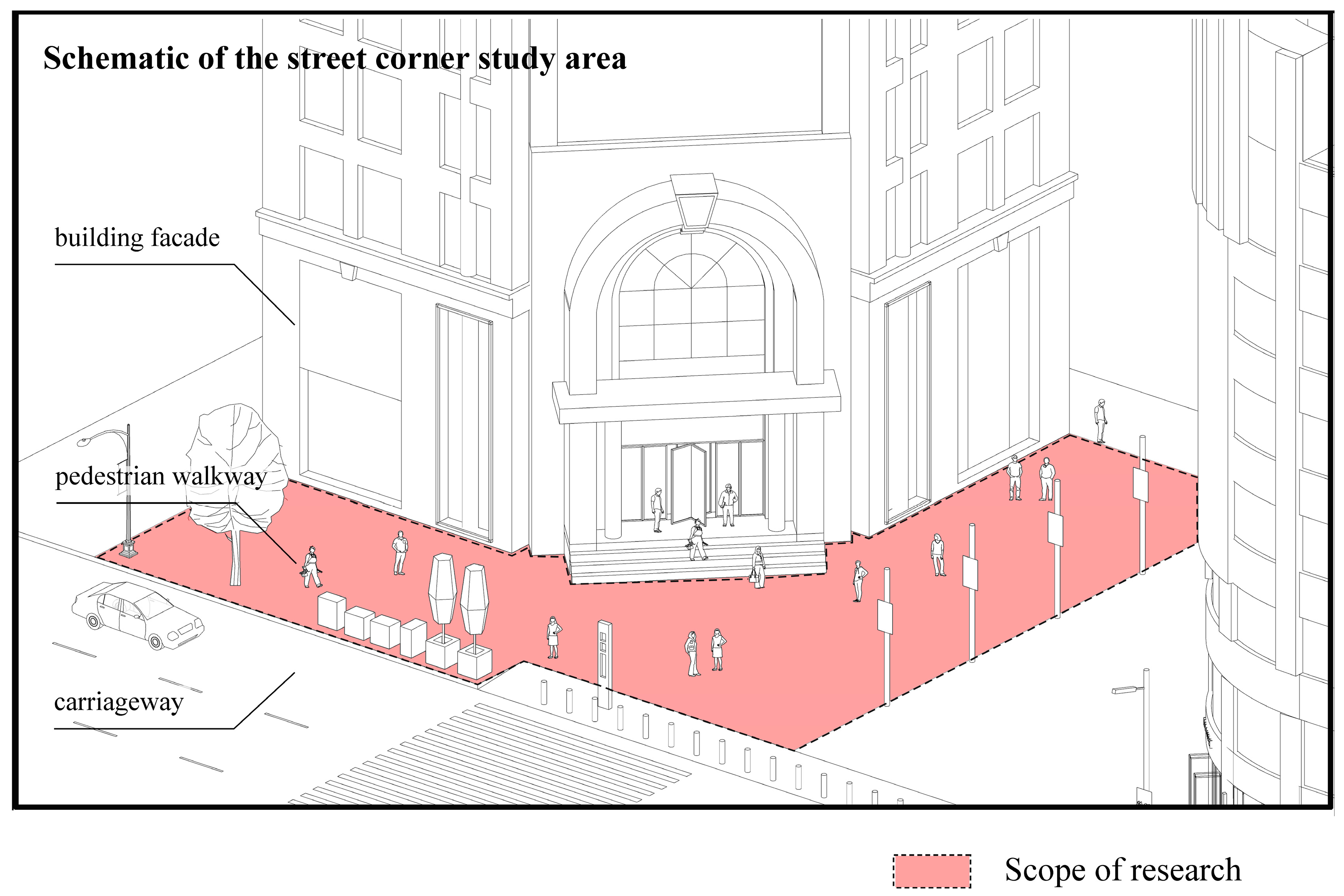
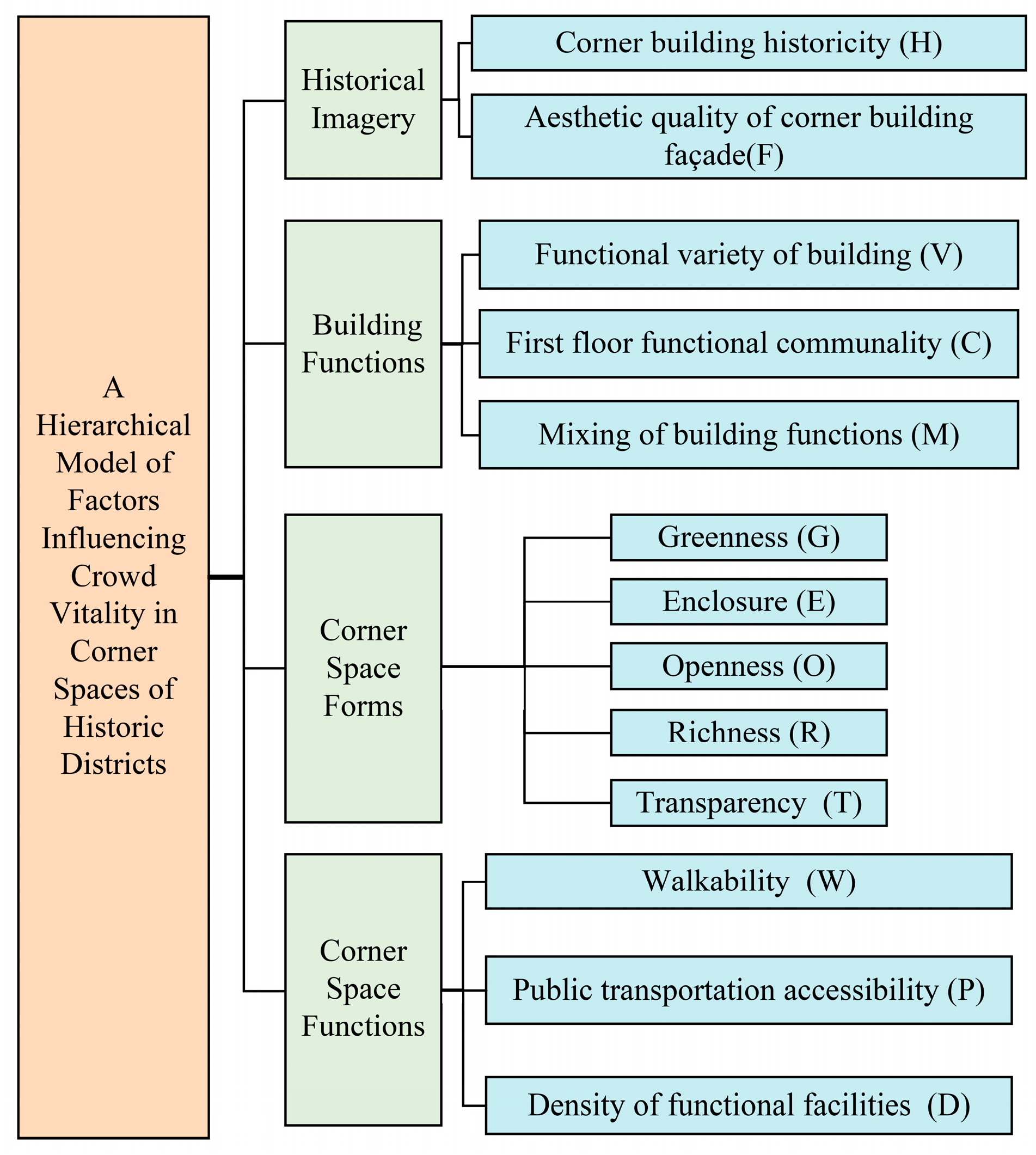



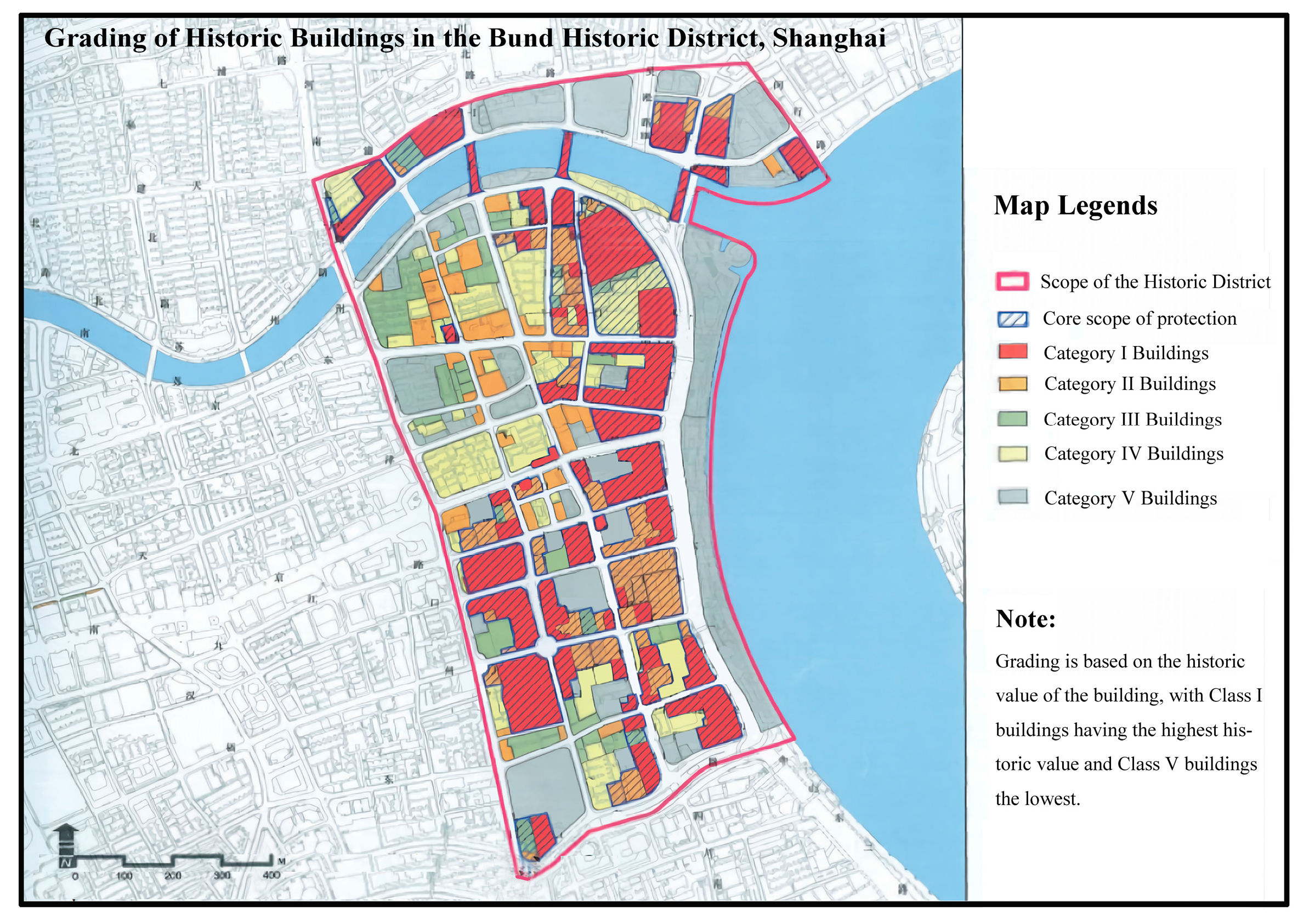
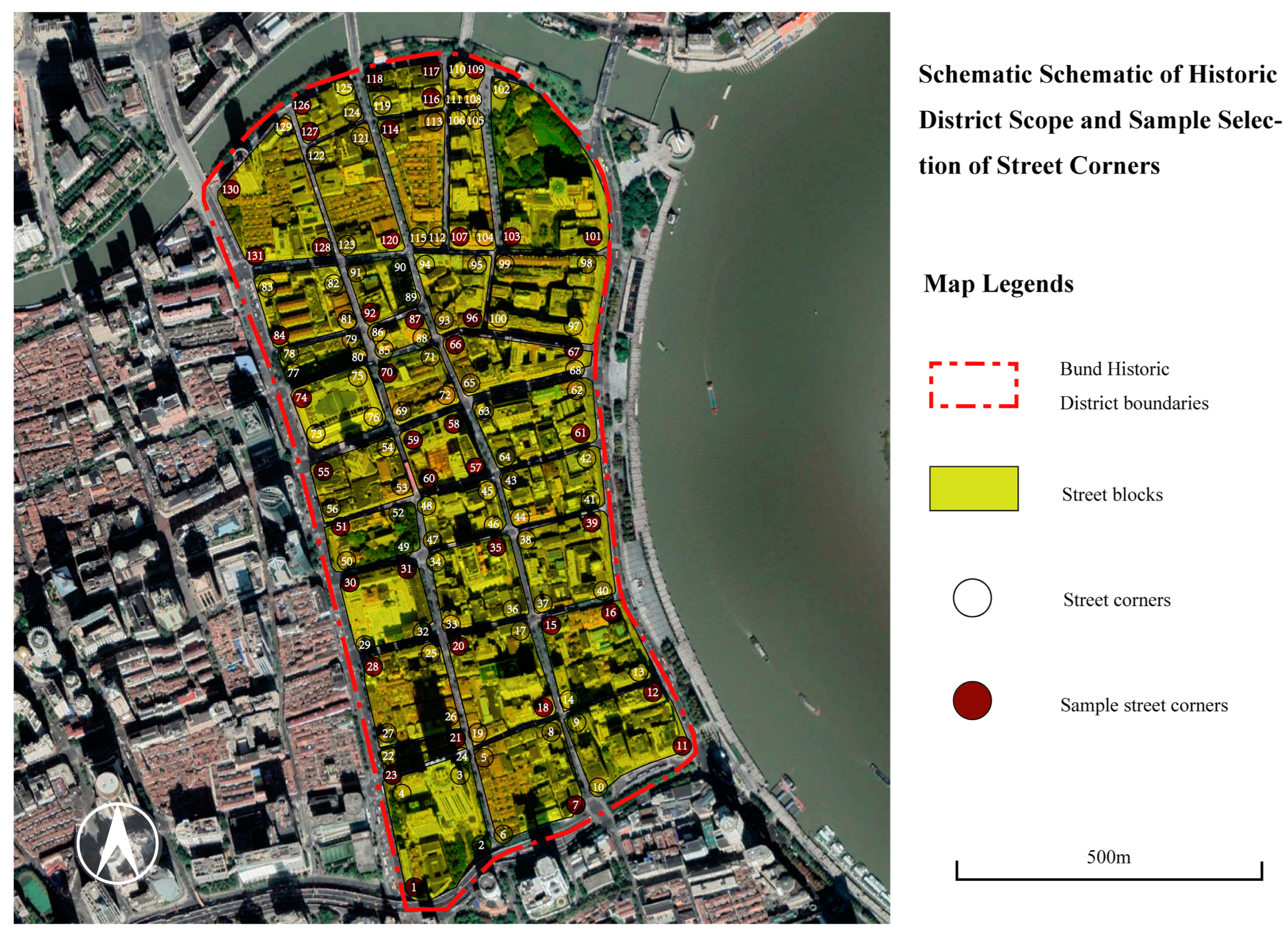

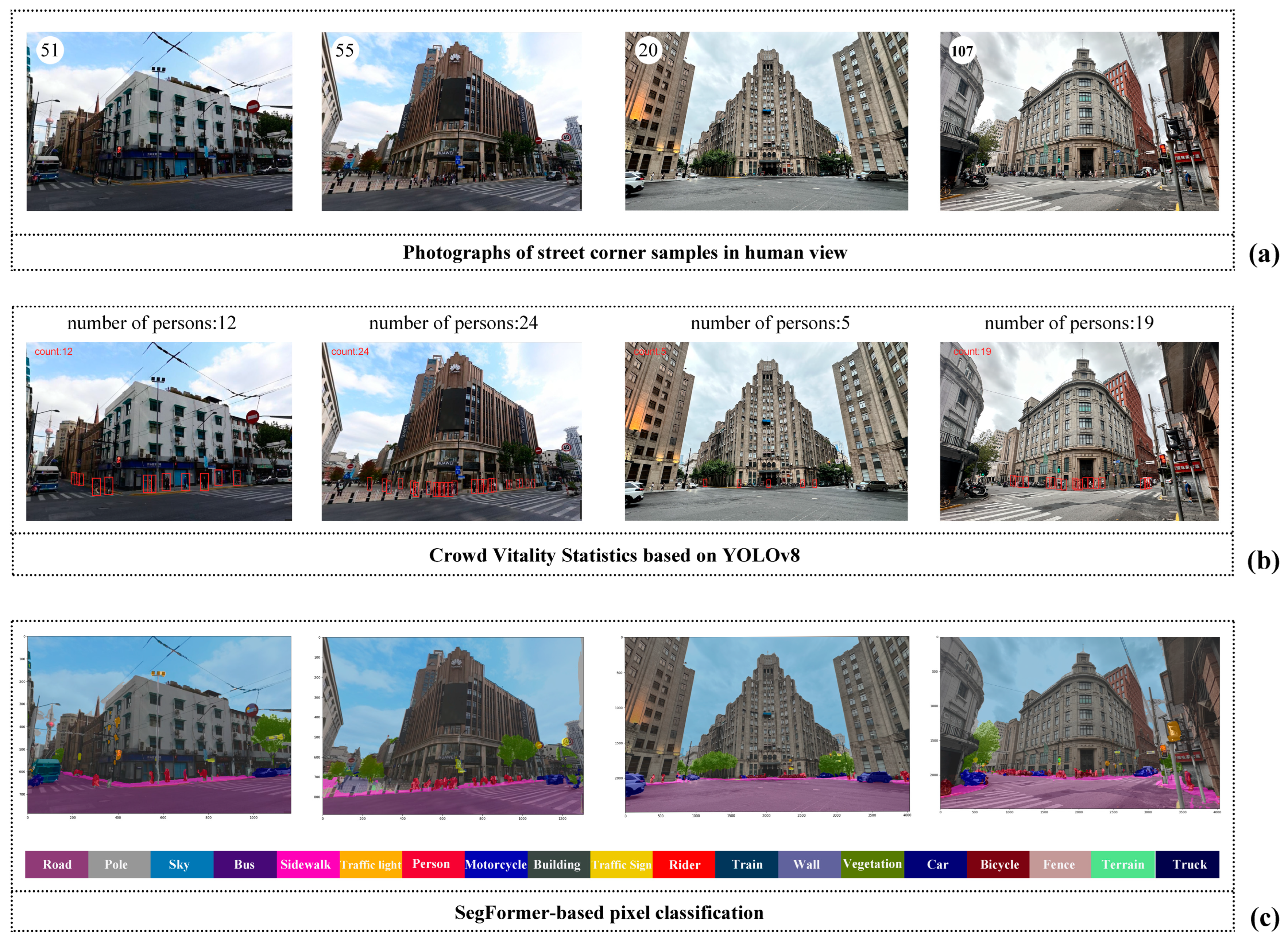

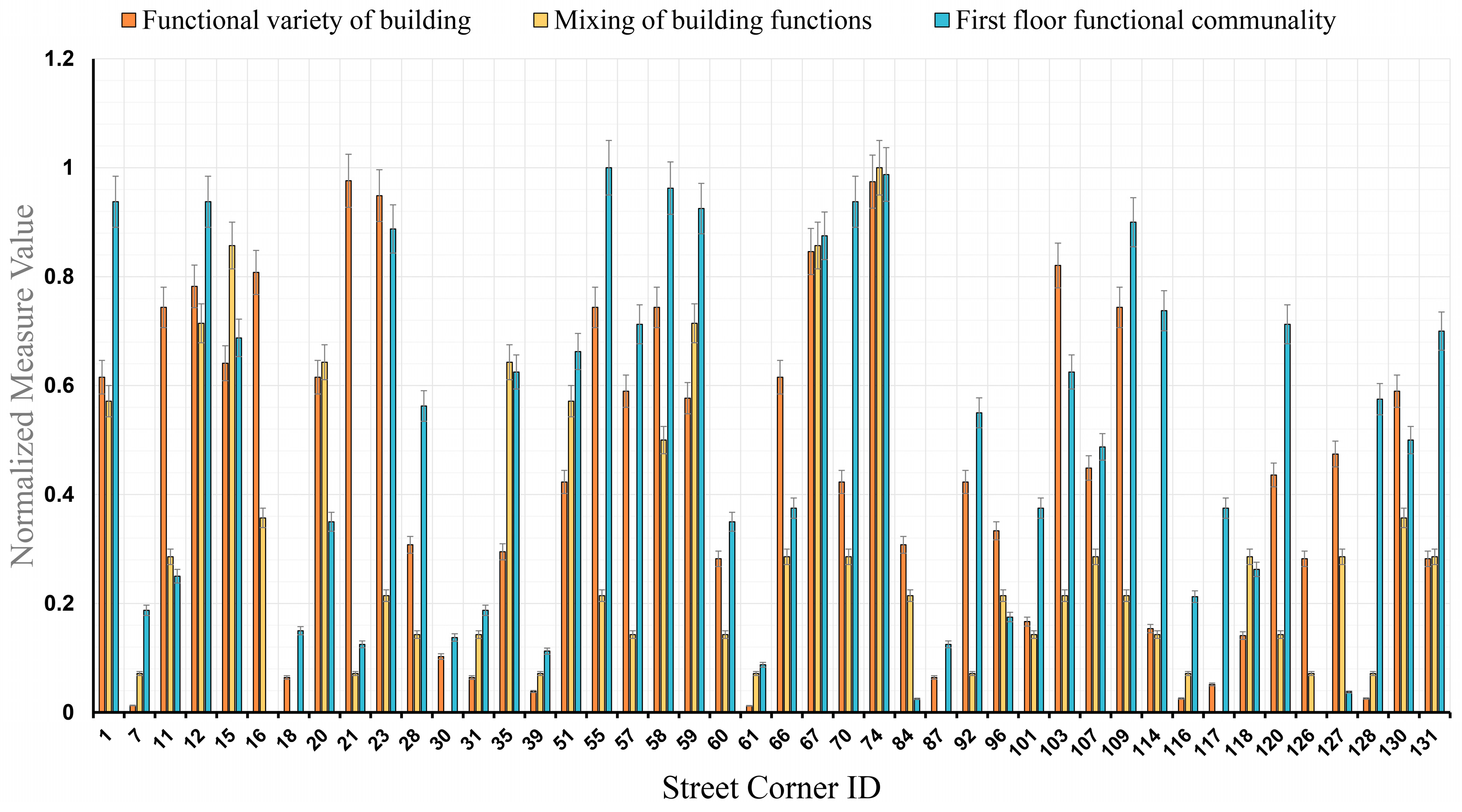

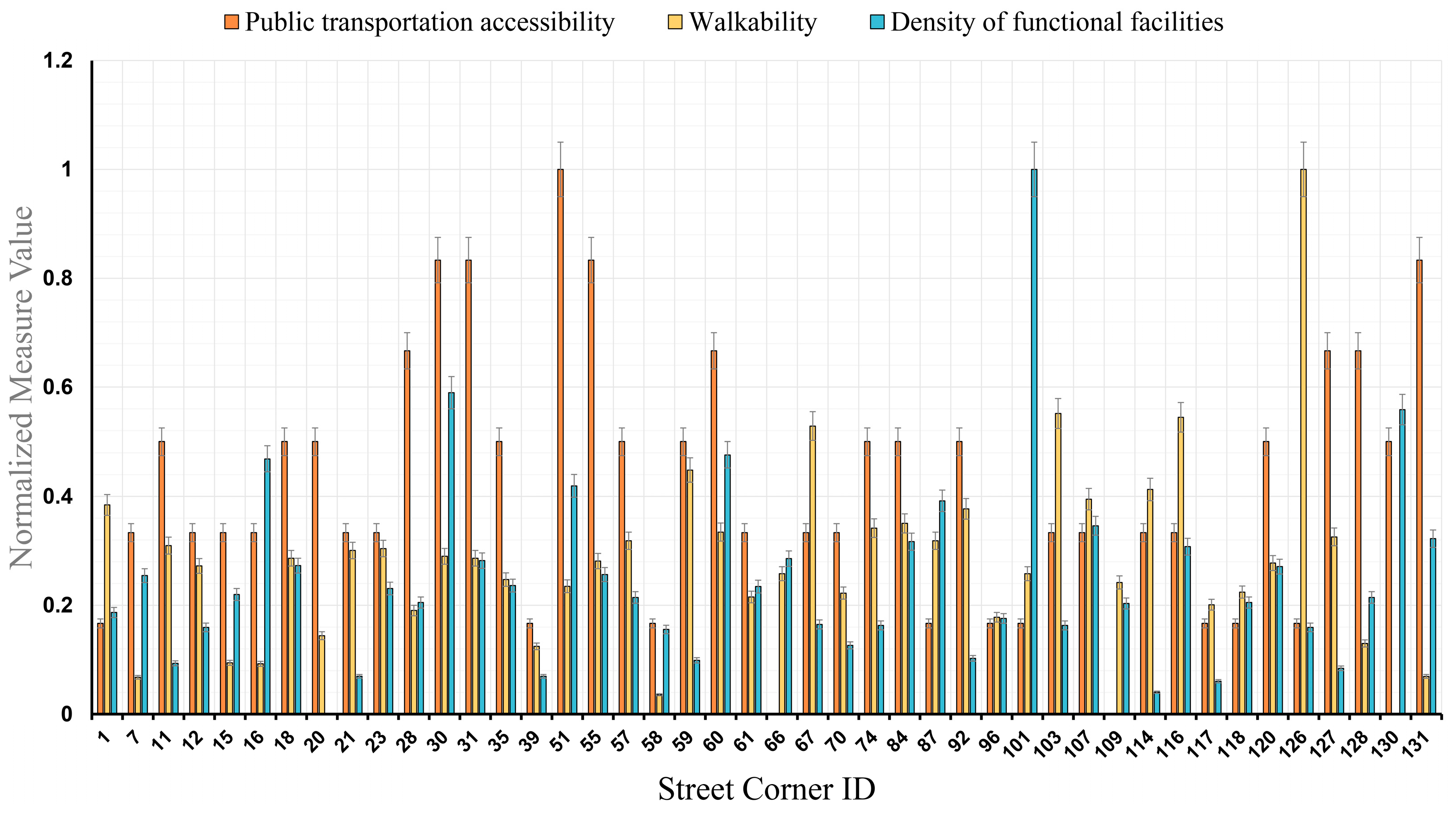
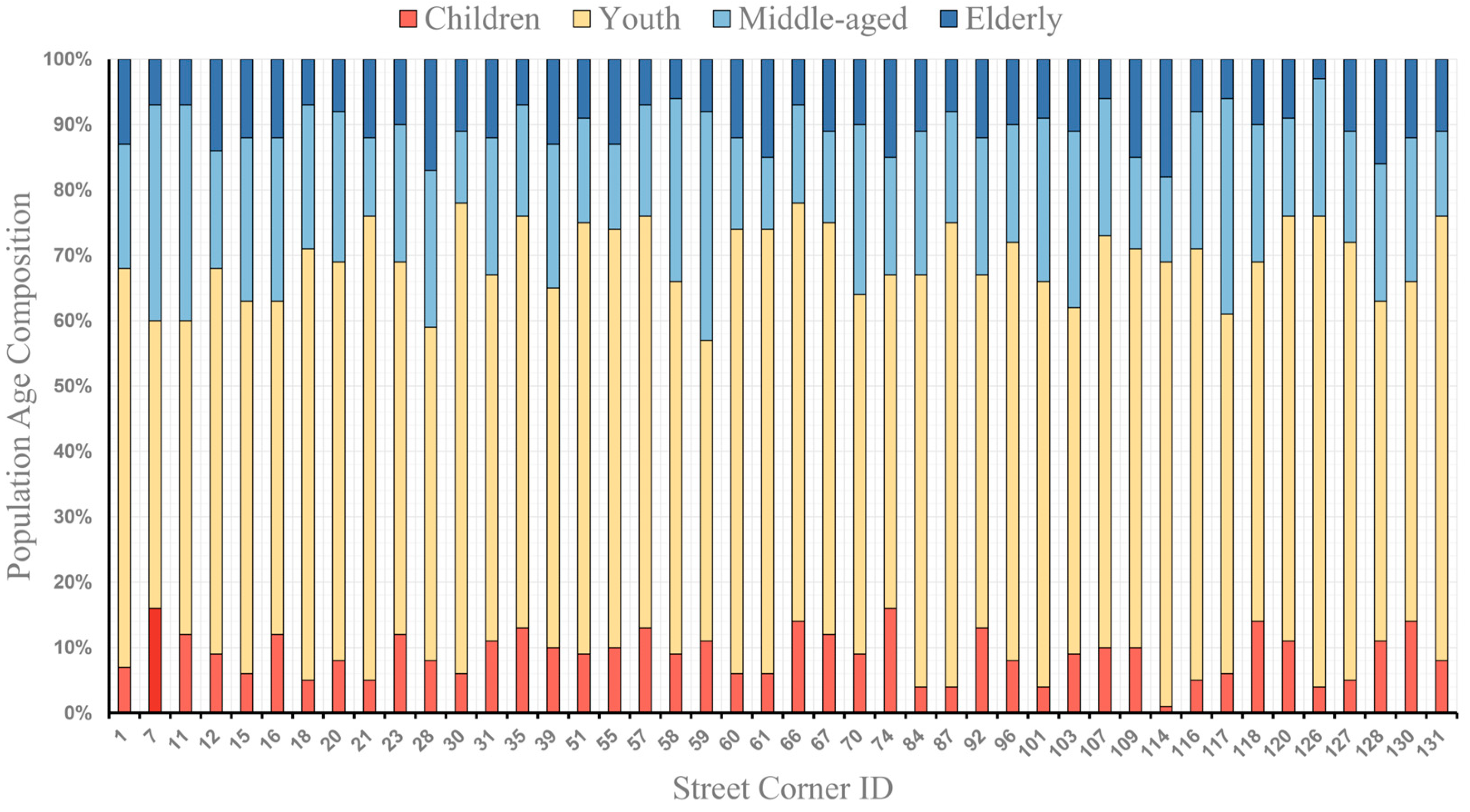
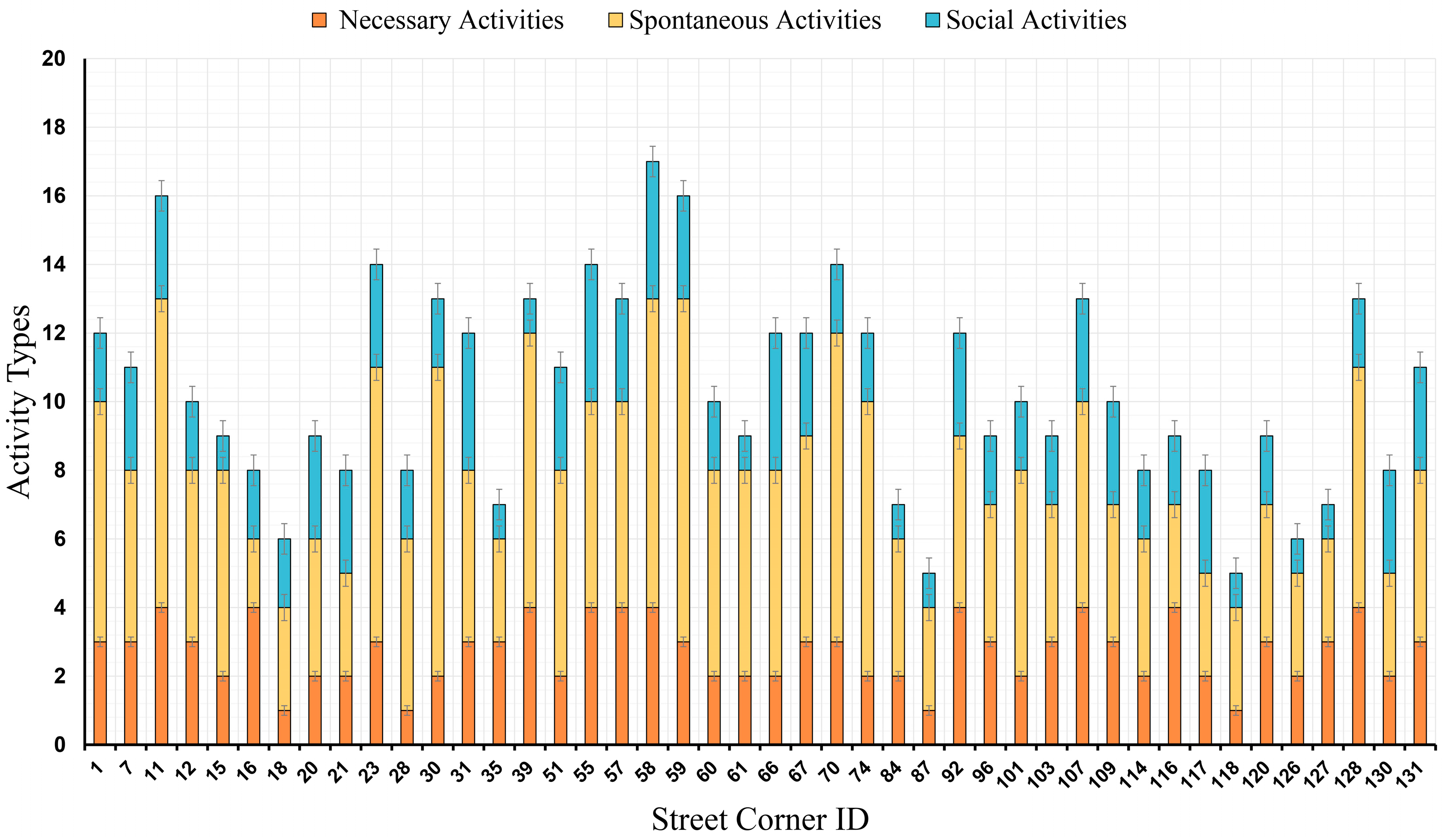
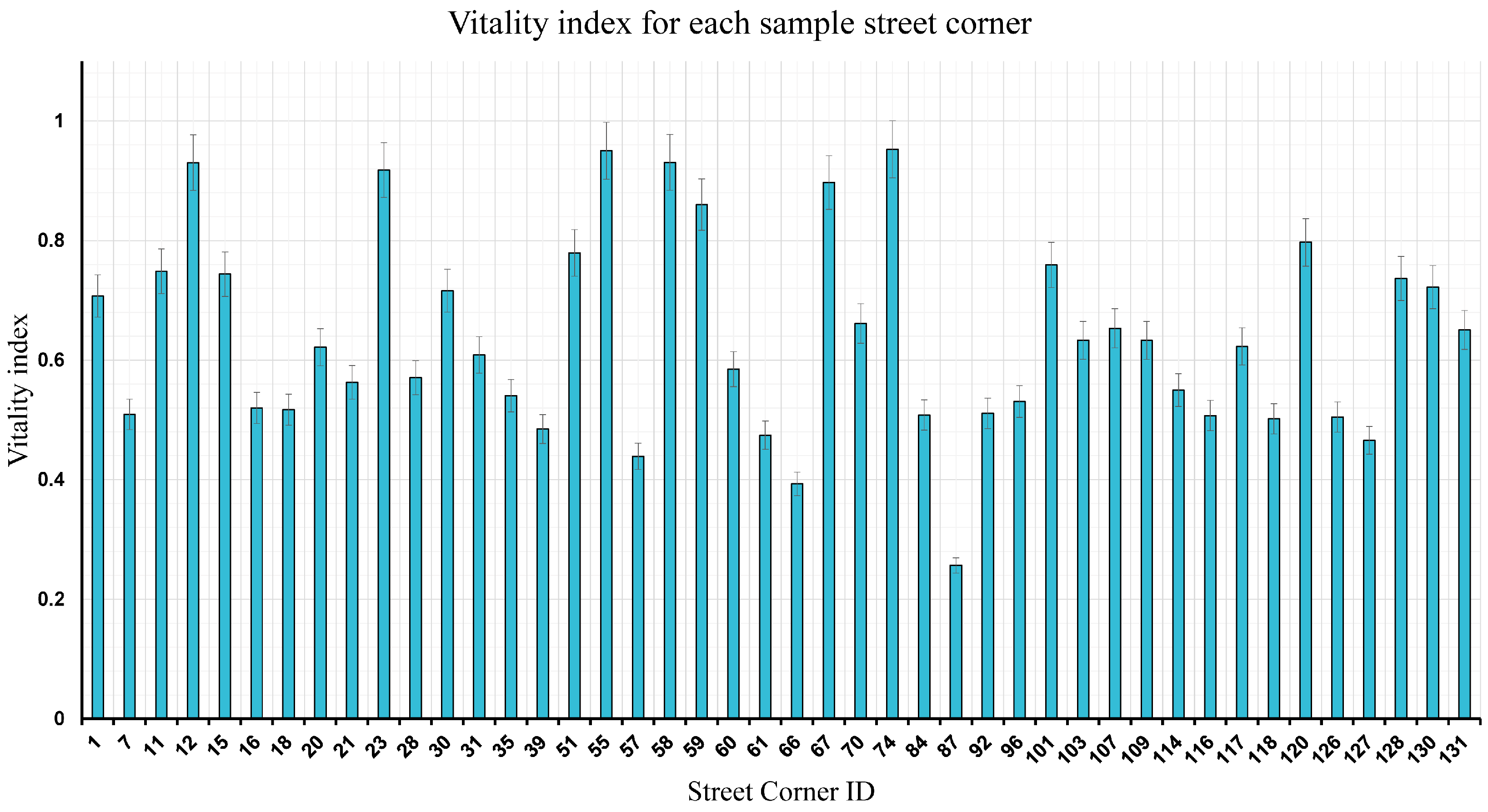
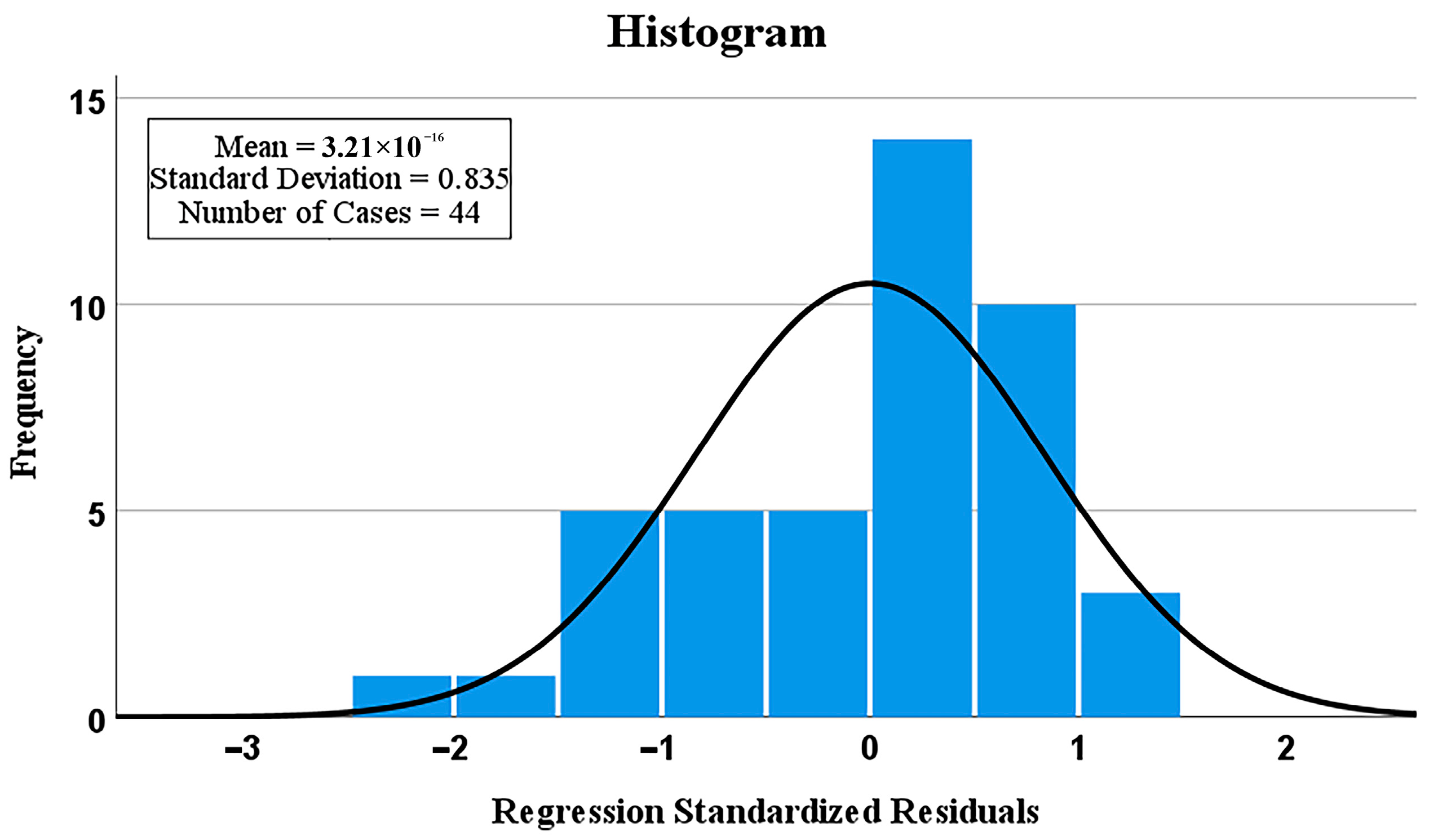
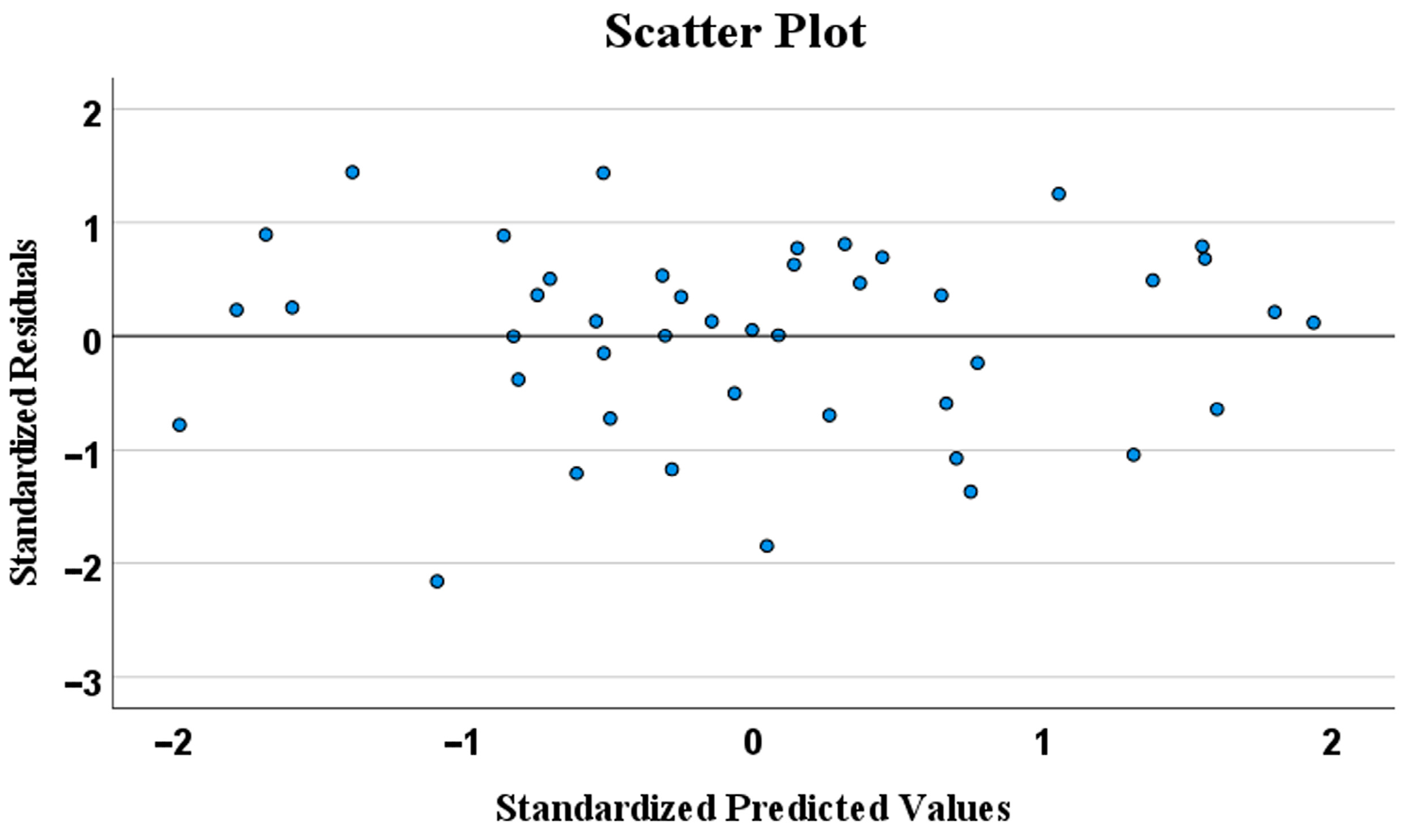

| Indicators | Quantification Method (Equation) | Explanation | |
|---|---|---|---|
| Building historicity (H) | Determine the historical quality score based on the historical building protection grading plan | The five levels in the planning diagram represent the historical quality of the buildings, scored from 1 to 5 | |
| Quality of street corner building facades (F) | Create a questionnaire for domain experts to score the aesthetic quality of the street corner building facades | Expert questionnaire scores range from 1 to 5 | |
| Mixing of building functions (M) | (1) | n denotes the number of functional categories pi denotes the percentage of total building functions in that functional category [2] | |
| First-floor functional communality (C) | (2) | The communal scoring of the building’s frequency of use and open time situation by the user population, Nf is the frequency of use score, Nt is the open time | |
| Functional variety of building (V) | (3) | n represents the number of functional categories | |
| Greenness (G) | (4) | Trn represents the pixels of street trees, Brn represents the pixels of shrubs and flowers, Grn represents the pixels of lawns [12] | |
| Enclosure (E) | (5) | Bn represents the pixels of buildings seen within the field of view, Trn represents the pixels of trees, Rn represents the pixels of vehicle lanes, P1 represents the pixels of sidewalks [12] | |
| Openness (O) | (6) | Sn represents the pixels of the sky [12] | |
| Richness (R) | (7) | S represents the number of types of elements in the street corner image, N represents the total number of elements in the street corner | |
| Transparency (T) | (8) | Lo represents the length of the open face of the building, Lt represents the length of the transparent face of the building, Lw represents the length of the transparent display window, L represents the length of the opaque wall, L represents the total length of the building’s ground floor interface. transparent display window, Ls represents the length of the opaque wall, L represents the total length of the building’s ground floor interface [36] | |
| Public transport accessibility (P) | (9) | Nb and Ns are the numbers of bus stops and subway stations within 400 m of the street corner | |
| Walkability (W) | (10) | P1n represents the pixels of sidewalks, Fn represents the pixels of partition fences, Rn represents the pixels of vehicle lanes [12] | |
| Density of functional facilities (D) | (11) | In represents the proportion of pixels occupied by facilities | |
| Category | Factors (Variable) | Minimum Value | Maximum Value | Mean Value | Standard Deviation |
|---|---|---|---|---|---|
| Historical Imagery | Corner building historicity (H) | 1.000 | 5.000 | 3.750 | 1.366 |
| The aesthetic quality of the corner building facade (F) | 1.800 | 5.000 | 3.918 | 0.769 | |
| Building Functions | Mixing of building functions (M) | 0.012 | 0.976 | 0.432 | 0.301 |
| Functional variety of building (V) | 2.000 | 16.000 | 5.932 | 3.669 | |
| First-floor functional communality (C) | 1.500 | 9.500 | 5.389 | 2.611 | |
| Corner Space Forms | Greenness (G) | 0.000 | 0.278 | 0.065 | 0.072 |
| Enclosure (E) | 0.915 | 8.989 | 3.459 | 1.870 | |
| Openness (O) | 0.053 | 0.451 | 0.219 | 0.103 | |
| Richness (R) | 3.364 | 5.242 | 4.319 | 0.440 | |
| Transparency (T) | 0.091 | 0.882 | 0.608 | 0.176 | |
| Corner Space Functions | Public transportation accessibility (P) | 0.000 | 6.000 | 2.500 | 1.406 |
| Walkability (W) | 0.001 | 0.057 | 0.017 | 0.009 | |
| Density of functional facilities (D) | 0.001 | 0.055 | 0.014 | 0.010 |
| Indicators | Calculation Equation | Explanation | Weight Values from the Coefficient of Variation Method | |
|---|---|---|---|---|
| Average Vitality Density () | (13) | N is the total number of photos, Pi is the number of people in each street corner photo [41]. | 0.312 | |
| Vitality Stability Index (S) | (14) | S is the vitality stability index, , and are the maximum and minimum values of the crowd density standard deviation, and is the average standard deviation of crowd density [41]. | 0.285 | |
| Diversity of Age Composition (Dy) | (15) | N represents the number of age group categories, Pi represents the percentage of the population in that age group [2]. | 0.182 | |
| Diversity of Activity Types (Da) | (16) | n represents the number of activity types, Pi represents the percentage of that type of activity in the total number of activities [2]. | 0.221 | |
| Regression Model | R | R2 | Adjusted R2 | Std. Error of the Estimate | Durbin–Watson |
|---|---|---|---|---|---|
| 0.918 | 0.843 | 0.775 | 0.093 | 1.792 | |
| Variance analysis | Sum of squares | df | Mean Square | F | p-value |
| Regression | 1.394 | 13 | 0.107 | 12.392 | 0.000 |
| Residual | 0.260 | 30 | 0.009 | ||
| Total | 1.654 | 43 |
| Variables | Unstandardized Coefficients | Standardized Coefficients | Multicollinearity | ||||
|---|---|---|---|---|---|---|---|
| B | Std. | Beta | t | p-Value | Tolerance | VIF | |
| Constant | 0.314 | 0.071 | 4.440 | 0.000 | |||
| Corner building historicity (H) | 0.238 | 0.029 | 0.517 | 8.225 | 0.000 | 0.765 | 1.308 |
| Quality of street corner building facades (F) | 0.055 | 0.044 | 0.087 | 1.260 | 0.217 | 0.815 | 1.226 |
| Mixing of building functions (M) | 0.019 | 0.050 | 0.038 | 0.377 | 0.709 | 0.391 | 2.558 |
| Functional variety of building (V) | 0.167 | 0.051 | 0.288 | 3.246 | 0.003 | 0.495 | 2.021 |
| First-floor functional communality (C) | 0.195 | 0.043 | 0.420 | 4.577 | 0.000 | 0.464 | 2.157 |
| Greenness (G) | 0.181 | 0.046 | 0.297 | 3.947 | 0.000 | 0.531 | 1.882 |
| Enclosure (E) | 0.078 | 0.053 | 0.119 | 1.465 | 0.153 | 0.593 | 1.687 |
| Openness (O) | 0.203 | 0.056 | 0.347 | 3.640 | 0.001 | 0.429 | 2.334 |
| Richness (R) | 0.046 | 0.048 | 0.070 | 0.960 | 0.345 | 0.724 | 1.382 |
| Transparency (T) | 0.265 | 0.055 | 0.388 | 4.777 | 0.000 | 0.590 | 1.696 |
| Public transportation accessibility (P) | 0.006 | 0.046 | 0.009 | 0.135 | 0.894 | 0.646 | 1.547 |
| Walkability (W) | 0.184 | 0.007 | 0.214 | 4.481 | 0.000 | 0.788 | 1.269 |
| Density of functional facilities (D) | 0.277 | 0.054 | 0.311 | 5.123 | 0.000 | 0.821 | 1.218 |
| Factors | Standardized Coefficients | Vitality Impact Degree |
|---|---|---|
| Corner building historicity (H) | 0.517 | 18.57% |
| First-floor functional communality (C) | 0.420 | 15.09% |
| Transparency (T) | 0.388 | 13.96% |
| Openness (O) | 0.347 | 12.48% |
| Density of functional facilities (D) | 0.311 | 11.16% |
| Greenness (G) | 0.297 | 10.69% |
| Functional variety of building (V) | 0.288 | 10.36% |
| Walkability (W) | 0.214 | 7.69% |
| Total | 2.782 | 100.00% |
Disclaimer/Publisher’s Note: The statements, opinions and data contained in all publications are solely those of the individual author(s) and contributor(s) and not of MDPI and/or the editor(s). MDPI and/or the editor(s) disclaim responsibility for any injury to people or property resulting from any ideas, methods, instructions or products referred to in the content. |
© 2024 by the authors. Licensee MDPI, Basel, Switzerland. This article is an open access article distributed under the terms and conditions of the Creative Commons Attribution (CC BY) license (https://creativecommons.org/licenses/by/4.0/).
Share and Cite
Wen, Z.; Zhao, J.; Li, M. A Study on the Influencing Factors of the Vitality of Street Corner Spaces in Historic Districts: The Case of Shanghai Bund Historic District. Buildings 2024, 14, 2947. https://doi.org/10.3390/buildings14092947
Wen Z, Zhao J, Li M. A Study on the Influencing Factors of the Vitality of Street Corner Spaces in Historic Districts: The Case of Shanghai Bund Historic District. Buildings. 2024; 14(9):2947. https://doi.org/10.3390/buildings14092947
Chicago/Turabian StyleWen, Zehua, Jiantong Zhao, and Mingze Li. 2024. "A Study on the Influencing Factors of the Vitality of Street Corner Spaces in Historic Districts: The Case of Shanghai Bund Historic District" Buildings 14, no. 9: 2947. https://doi.org/10.3390/buildings14092947
APA StyleWen, Z., Zhao, J., & Li, M. (2024). A Study on the Influencing Factors of the Vitality of Street Corner Spaces in Historic Districts: The Case of Shanghai Bund Historic District. Buildings, 14(9), 2947. https://doi.org/10.3390/buildings14092947




